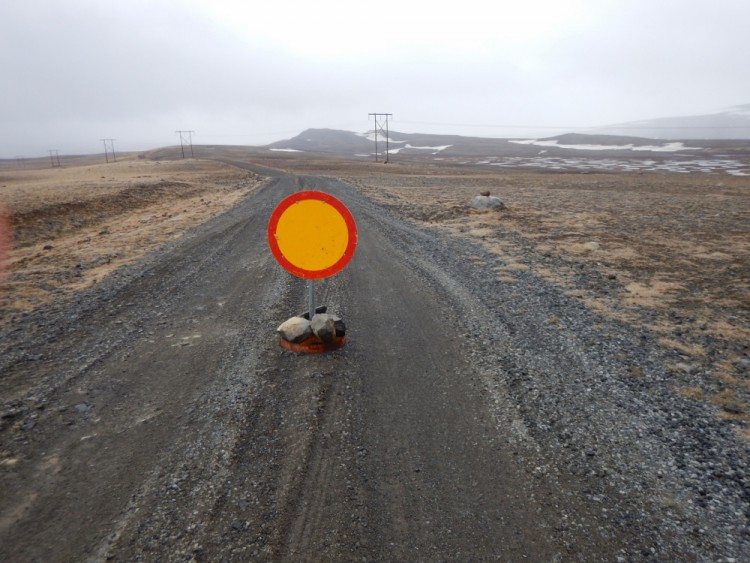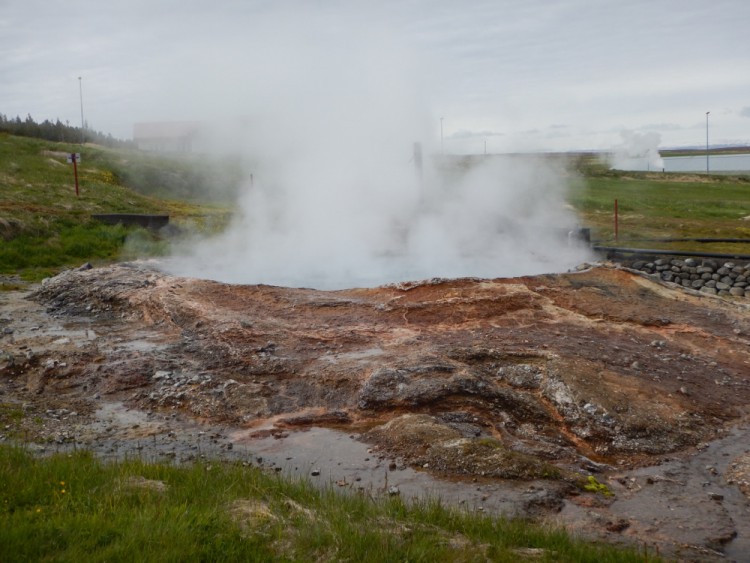The following post is part of our “My Destination” series, in which staff or clients of Nordic Visitor tell us about their favourite highlights from our Nordic destinations.
The only thing we love more than being out on the road ourselves is seeing our travellers' adventures unfold in words and pictures. Alice and Bob Friedenson, who travelled on a custom version of our Iceland Grand Tour to celebrate their 51st wedding anniversary, documented each day of their 21-day journey in June.
Using the Pages app on her iPad, Alice, a sculptor and retired math teacher, kept up the daily travel journal while her husband Bob, a photographer and retired engineer/computer scientist, maneuvered their 4x4 rental jeep counter-clockwise around Iceland. Combined they took more than 4000 photos!
In the second of this three-part series, we follow them as they spot wild reindeer, puffins, whales, seals and more from the East Fjords to the West Fjords.
June 12 – 13, 2015: East Fjords
With temperature in the 30's (F), we had a variety of heavy rain, snow, and beautiful blue sunny sky. They call this summer. In spite of the weather, the fjords are beautiful and when the sun is out the mountains are very colorful, in shades of grey, black brown, red, green and orange with volcanic rock, with glaciers and snow also in view. When the sun shines, rivers are azure.
The roads are good, even the dirt ones, no potholes unlike Costa Rica. Mountain roads are windy, bridges are one lane as are some mountain tunnels but all have ample pullouts for cars to wait if another is coming at you. Snow and wind did prevent us from two excursions but there is so much to explore here it really doesn't matter. Bob handles the challenge well.
No day is complete without a waterfall, and still we found sheep continuously. Reindeer were easily visible this time.
Other highlights today: Arctic char from fish farms along the fjords, a grass covered home in Fáskrúðsfjörður, puffins found outside of Bakkagerði in the Hafnarhölmi Harbor and mountain snow.
June 14 – 15, 2015: Lake Mývatn & North Iceland
Icelandic Nobel award-winning author Halldór Laxness's book Independent People describes the desolation and harsh winters on the moorland of Jökuldalsheiði. The farm that inspired his book is now a tourist destination which we tried to visit on our way to Lake Mývatn. His descriptions more than matched this part of our journey. Five kilometers from the farm we saw a road closing sign. The physical surroundings are dismal and beyond isolation. We had strong winds, torrential rains, and saw a car with 4 flat tires.

Continuing our journey, we were close to Mývatn when we saw huge fields of smoke but no fire. Geysers were erupting!

We also climbed a volcano to see its crater and saw unusual lava formations at Dimmuborgir!
Made a stop at Mývatn Nature Baths, where the water is heated to about 100 degrees F by geothermal steam from deep under the ground.
Then there was Goðafoss, “waterfall of the gods”, where pagan chieftain Þorgeir Ljósvetningagoði, hurled his statues of Norse gods into the waterfall after embracing Christianity in 1000 AD.
Further on we enjoyed whale watching from Húsavík (that is the picture in the cover image of this post). This Great Blue Whale was easily visible without binoculars. Great Blues do not breach.
This day was a wonderful heat wave, sunny all day with temperatures of 42 - 48 F. We drove through desolate country all the way. We saw geothermal vents used for heating homes, greenhouses, and swimming pools. Snow covered glaciers, small towns (5-10 houses), sheep and cattle farms, grey lava were everywhere.
The day’s other highlights:
- Visited the Dettifoss waterfall, the most powerful falls in Europe
- I found an Icelandic doll collection at the Safnasafnið Folk Museum
- Vsited the botanical gardens in Akureyri, where little was blooming due to very late spring weather
- Enjoyed typical Fjord scenery
- Visited an old herring factory in Siglufjörður
- Met some roosters that begged just like dogs
- Enjoyed ice cream on a dairy farm
- Visited a folk music museum and a horse farm in Skagafjörður
June 16, 2015: Northwest Iceland
The temperature hit 60 F today! No need for long underwear. We spent most of the day driving along the ocean finding seals off Illugastaðir.
Saw more volcanoes, mountains, sheep, and horses along the way. We are geographically close to Greenland. At Borgarvirki, we found a natural fortress resulting from a volcanic plug, it reminded me of Massada and was actually once used for defense.
June 17 – 18, 2015: Ísafjörður & northern West Fjords
Two fabulous days in the area of Ísafjörður, the largest city in the West Fjords with a population of 3000, on another beautiful fjord.
It was sunny, 41 degrees F, as we drove along the top of an 1,800 foot mountain completely covered with snow, along with surreal uninhabited fjords, a few sheep, hay fields, waterfalls, and at last a small farm. Birds nest near the river. I found a small conch shell, the first of any we had seen. The western fjords are much narrower than the eastern ones. What looks like a short drive between two towns is greatly increased in length driving up and down the fjords, but so is the beauty.
An interesting aside: the directories of names here, whether the phone book or our tour company, are alphabetized by first name.
In Heydalur we enjoyed more seals, including one that practically breached like a whale. We saw more fluffy sheep and grass covered buildings. The drive included quick transitions from aqua waters to muddy streams, austere dark brown-black mountains to rich lime green and—happily—lots of sun.
We stopped at a small fox museum in Súðavík. Foxes are the only land animals that came to Iceland naturally. They crossed over ice from Greenland and are much smaller than foxes in Canada, an adaptation due to intense cold and scarcity of food for them.
We arrived in Ísafjörður in time for the Icelandic National Day celebration. A band led the people, some in traditional dress, in a parade from the town square to the town park nestled beneath a snow covered mountain. The band continued to play, a chorus sang, and there were several speeches. I thought it would be an opportunity to taste different local foods but instead they sold hot dogs and cotton candy. It was fun to see so many families with young children enjoying the festivities.
Later, we walked the streets enjoying brightly colored buildings and the waterfront before having dinner at a small restaurant with lots of locals. We both enjoyed steak. Fruit and veggies are all imported. It is too cold to grow them and so I treasure them when served.
The next morning I kayaked with a local guide, a young woman studying bio-engineering in Reykjavik. She is from Ísafjörður. It was wonderful to see the mountains from the water, paddling along fjords where there was little sign of people and many birds.

In the afternoon we went on a small motor-powered boat to Vigur Island, a tiny peaceful island 35 minutes away with puffins and eider ducks, where there is just a small farm inhabited by only one family. Strong cold winds prevailed. Birds nested. Lots of puffins, with personalities like penguins. We carried sticks to keep the Arctic terns from attacking us. The boat ride back was in rough ocean water with huge waves.
Other observations:
- Fleece from puffins nests, washed and cleaned are used to make warm down clothing.
- People are extremely honest here. Crime does not seem to exist.

June 19, 2015: West Fjords
Had breakfast at a fabulous bakery in Ísafjörður. Sunny, blue skies, good pastry, and 47 F.
Iceland has an amazing tunnel system; they work hard to keep roads in very good shape. We drove up and down tranquil fjords, mountains, narrow dirt (mostly mixed with lava pebbles) roads, looking up at snow bowls and down at rivers from more than 500 meters and wondering whether falling rocks or a fall from a cliff was worse.
At 100 meters we saw more vegetation than previously, more color in the fjords, various shades of aqua and blue rivers, more fish farms, birds nesting, sheep grazing, yellow sand beaches, bright canary-greenish yellow moss and red rather than brown or black earth on roads and mountains.
The highlight of the day was the very impressive seven-tiered Dynjandi waterfall, which is 100 feet high. It was a nice hike past other waterfalls to its base.
Later we had dinner with a couple from Belgium and then went to the Látrabjarg cliffs to see puffins.
Stay tuned for Part 3! Catch up here with Part 1 - Reykjavik to Höfn.
Heartfelt thanks to Alice and Bob for sharing their Iceland travel diary with us! To make your own Nordic travel story, check out all the possibilities offered by Nordic Visitor.














